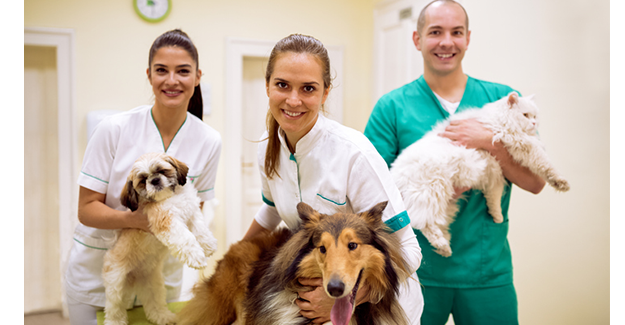NEWStat®
 Subscribe to get NEWStat delivered directly to your inbox! Delivered every Tuesday, Thursday, and Saturday, NEWStat is boosted by artificial intelligence to deliver a newsletter that is tailored to you.
Subscribe to get NEWStat delivered directly to your inbox! Delivered every Tuesday, Thursday, and Saturday, NEWStat is boosted by artificial intelligence to deliver a newsletter that is tailored to you.
Featured article
Why staff retention deserves your attention in the New Year
AAHA surveyed nearly 15,000 veterinary professionals and learned that 30% plan to leave their current job within the coming year. What might make them want to stay? It starts with the right goals.
Trends free article
How Do We Keep Good People in Clinical Practice?
New insights from an AAHA survey into why people in vet med leave, and what could make them want to stay.
Recent articles
-
February 3, 2009
Student Debt: Threat or Opportunity?
Several perspectives on this topic are covered in depth in a special February issue of Trends magazine. It’s time to take another look at veterinary student debt, according to AAHA President-Elect John Tait, DVM, MBA, CFP. As framed to date, discussions about student debt, often dubbed the elephant in the room, have focused on the fact that the salaries of recent graduates are insufficient to pay student loans and attain the lifestyle generally associated with professional status. But the value of a veterinary degree isn’t measured by the salary you earn early in your career, Tait maintained during a session at the North American Veterinary Conference in January. -
February 3, 2009
Practices take a hit from ice storm
Hundreds of thousands of people in Kentucky, Arkansas and Missouri lost their electricity in last week’s devastating ice storm, and veterinary practices were not immune to the damage. Some fared better than others, however. Ron Eby, DVM, of St. Francis Veterinary Clinic in Green Forest, Ark., said his practice was without electricity for a week. The storm hit Jan. 26, and Eby’s practice lost power the next day until Feb. 2, he said. Fortunately no animals suffered at the practice. Several animals were being boarded there, but because the building rests on a 4,500-square-foot concrete slab, the indoor area remained at 62 degrees even with no heat. “The worst thing for us was the loss of a whole week’s work,” Eby said. “It’s amazing how dependent we are on the phones and electricity.” -
January 20, 2009
NAVC economic sessions offer predictions, advice
Half of veterinarians participating in a survey this week said they expect to cut staff hours in an effort to save jobs during 2009. The survey was conducted during a symposium on economic issues and the recession at the North American Veterinary Conference in Orlando, Fla. Student debt, economic forecasts, and lessons from a multi-practice owner weathering the recession in the long-struggling Midwest were also front-and-center at the conference. -
January 20, 2009
Veterinary forensic science pioneers present at NAVC
The American Society for the Prevention of Cruelty to Animals (ASPCA) this month turned up the heat on animal abusers with two initiatives in Florida aimed to expand the small field of veterinary forensics. The University of Florida announced last week it is forming a Veterinary Forensic Sciences Program at the school’s William R. Maples Center for Forensic Medicine. The program is being formed with a $150,000 grant from the ASPCA, and a three-year commitment of support from the ASPCA, the university said in a news release. The opening day of the North American Veterinary Conference in Orlando, Fla., on Jan. 17, also featured a series of presentations on “Animal CSI – Veterinary Forensics,” sponsored by the ASPCA. -
January 6, 2009
Resolution time – Experts weigh in
Before the diet, workout and clean-the-garage New Year’s resolutions are firmly disregarded, violated or otherwise ignored, make one you will actually keep: Help out your practice. In light of the gloomy economic outlook for this year, we asked several experts what one thing they would advise a practice owner or manager to resolve to do for 2009. According to Peter Weinstein, VetPartners president elect and owner of Irvine, Calif.-based PAW Consulting, practices should do like Monty Python, and always look on the bright side of life. “Maintain a positive outlook on your practice, your life and the world around you,” Weinstein advises. -
January 6, 2009
Get your practice ready for the “Red Flags Rule”
This year, many veterinary practices will be required to comply with the federal “Identity Theft Red Flags and Address Discrepancies Under the Fair and Accurate Credit Transactions Act of 2003,” otherwise know as the “Red Flags Rule.” A Federal Trade Commission website helps explain the rule –designed to fight identity theft – and lays out the terms under which a business would need to follow it. Under the rule, which exists on the books now but will not be enforced until May 1, businesses that qualify as “creditors” and have “covered accounts” must develop and implement identity theft prevention programs. Accepting credit cards as payment does not necessarily qualify a business as a” creditor” under the rule, but businesses that bill consumers after services are provided are considered creditors. -
December 23, 2008
BREAKING NEWS: Fluffy and Fido commandeer vehicle
Two enterprising companion animals thwarted disaster today when the pair appeared to take over and repair a broken-down vehicle. The furry duo – cat Fluffy and dog Fido – were spotted in a snow-covered field with a large red sled or snowmobile that had seemingly ceased to function. -
December 23, 2008
AAHA credit survey: Most practices OK, but some cause for concern
A NEWStat survey of AAHA practice owners and managers shows that although the general health of the industry remains strong, significant percentages of practices are facing potential financial pitfalls. The survey, conducted in early December, asked a series of questions about how the credit crunch is affecting veterinary practices. One out of three practices said they are not able to fully cover monthly operating expenses with monthly income, and nearly 40 percent said they regularly or occasionally need to negotiate delayed payments to suppliers. Nearly a quarter of practices surveyed said they sometimes need to use personal cash to finance normal operating expenses, and three out of four practices reported having to use business credit cards to cover operating costs. -
December 9, 2008
Cash rules, credit drools
Nineties rap group Wu-Tang Clan once proclaimed: “Cash Rules Everything Around Me.” Turns out they were right. Just one year ago credit was king; today, small business and veterinary financial experts are all about cash—collecting it, using it and saving it wisely. Cash flow is the lifeblood of any small business. Most small businesses rely on cash to pay for normal operating costs month-to-month. As business grows soft, and with banks promoting low- or no-interest home equity loans, it can be tempting to bolster your business with “mini loans” — cash advances, planned overdrafts, deferred credit card payments, infusions from personal savings, and so on. Don’t do it. -
December 9, 2008
Veterinarians using credit wisely but worry about long-term survival
Preliminary results of an AAHA survey of practice managers and owners show that while most practices are doing well and making sound financial decisions, a significant percentage are spending more than they are making, and nearly a quarter (24 percent) of all practices surveyed are worried about the viability of their practice in light of a long-term credit crunch. In order to finance normal operating expenses, the most common type of credit that practices use is business credit cards, according to the survey. Only 25 percent of respondents said they never use them.





